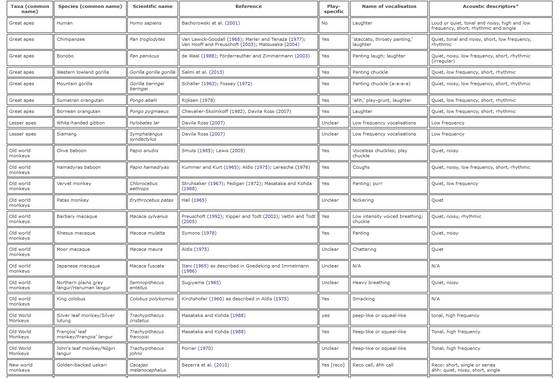Research results show that 65 species of animals, from primates to birds, 'laugh'

'Laughter' can mean discomfort, but it is generally a common sign of 'enjoyment'. A natural anthropologist at the University of California, Los Angeles has published a new study on the behavior of 'laughing': '65 species of animals, from primates to birds, laugh.'
Full article: Play vocalisations and human laughter: a comparative review
From apes to birds, there are 65 animal species that “laugh” | Ars Technica
https://arstechnica.com/science/2021/05/from-apes-to-birds-there-are-65-animal-species-that-laugh/
Do animals laugh? | Live Science
https://www.livescience.com/do-animals-laugh.html
Sasha Winkler, a researcher of natural anthropology at the University of California, Los Angeles, decided to study animal laughter because she was studying rhesus monkeys. While investigating rhesus monkeys, Winkler noticed that he gasped slightly while the rhesus monkeys were playing. From this discovery, Winkler searched past literature on 'animals that make noise while playing' and identified that 65 species, including primates and birds, laugh in some way.
Looking at the list published in the paper, most of the 65 species are large apes such as chimpanzees and bonobos, and primates of the Old World monkeys (old world monkeys) such as Japanese macaques, but domestic animals such as dogs, cats and cows. , rodents and sea lions, such as degu Miyama parrots are also included. In addition to these species names, the list also includes a rationale for laughing, which includes the 'bowing' and 'breathing' that dogs show before playing with their peers. There are also references to 'signs of play' other than laughter, such as the sign ''.

According to Winkler, these animals use laughter not only to signal the start of play, but also to indicate that they are not attacking. For example, the act of 'biting on the neck' can be seen in battle and in fluttering, but by biting on the neck while laughing, it is a sign that 'this is just play, not really trying to bite'. Mr. Winkler explains that he is sending.
'There is little research other than primates, and it is not even thought to play with fish, amphibians, and reptiles,' Winkler said of the laughter that these animals show. He said that while there was a mention of 'laughing' in studying a particular animal species, there was no comprehensive study that looked at it from the perspective of 'laughing animals.'
In addition, Mr. Winkler says that the laughter of human beings is different from the laughter of animals. It seems that laughter in animals is basically only as loud as the other person can hear, and unlike human beings, it rarely makes a voice that can be heard by others, Mr. Winkler said, 'The point that the voice is loud. Is a unique point in human laughter and will be an important area for future research. '
Related Posts:







